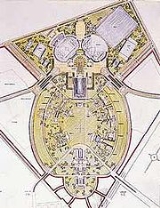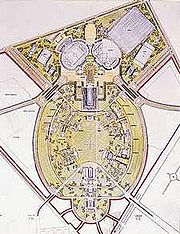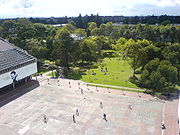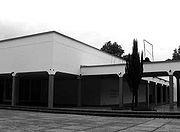
University City of Bogotá
Encyclopedia

National University of Colombia
The Universidad Nacional de Colombia , also called UNAL or just UN, is a public, national, coeducational, research university, located primarily in Bogotá, Medellín, Manizales and Palmira, Colombia...
, located near Teusaquillo
Teusaquillo
Teusaquillo is the 13th locality of Bogotá, capital of Colombia. It is located in the geographic center of the city, to the northwest of downtown. It is an urbanized locality with several green zones in its parks, avenues, and the campus of the National University of Colombia...
, in Bogotá
Bogotá
Bogotá, Distrito Capital , from 1991 to 2000 called Santa Fé de Bogotá, is the capital, and largest city, of Colombia. It is also designated by the national constitution as the capital of the department of Cundinamarca, even though the city of Bogotá now comprises an independent Capital district...
, Colombia
Colombia
Colombia, officially the Republic of Colombia , is a unitary constitutional republic comprising thirty-two departments. The country is located in northwestern South America, bordered to the east by Venezuela and Brazil; to the south by Ecuador and Peru; to the north by the Caribbean Sea; to the...
. It is the largest university campus in Colombia, with an overall area of 1200000 m² (296.5 acre) and a constructed area of 308541 m² (76.2 acre), giving it ample green areas, open spaces, and pedestrian paths. Amongst its buildings are seventeen that have been declared national monuments; these constitute a cross section of the last 60 years of Colombian architecture
Architecture
Architecture is both the process and product of planning, designing and construction. Architectural works, in the material form of buildings, are often perceived as cultural and political symbols and as works of art...
.
The University City Rafael Uribe began when Alfonso López Pumarejo
Alfonso López Pumarejo
Alfonso López Pumarejo was a two-time Colombian president and political figure, as a member of the Colombian Liberal Party. He served as president of Colombia for the first time between 1934 and 1938 and again between 1942 and 1945....
, in his first term of office as president of the country, envisioned the National University of Colombia as a modern, evolutionary, and experimental infrastructure including a balance of science and arts. The University City in Bogotá of National University of Colombia
National University of Colombia
The Universidad Nacional de Colombia , also called UNAL or just UN, is a public, national, coeducational, research university, located primarily in Bogotá, Medellín, Manizales and Palmira, Colombia...
may be viewed as an example of the architectonic expression of the modernization of the State from 1930 to the present time.

To design the university, which had until then distributed academic functions across scattered locations throughout Bogotá
Bogotá
Bogotá, Distrito Capital , from 1991 to 2000 called Santa Fé de Bogotá, is the capital, and largest city, of Colombia. It is also designated by the national constitution as the capital of the department of Cundinamarca, even though the city of Bogotá now comprises an independent Capital district...
and to different governmental organizations, the national government invited architect Fritz Karsen, expert in university subjects, and the architect Leopold Rother
Leopold Rother
Leopold Siegfried Rother Cuhn was a German architect, urban planner and educator. He developed important projects particularly in Colombia. The most known project was the design of the Campus of the Universidad Nacional de Colombia in Bogotá.- External links : - Biography...
to come assist them. Karsen defined and integrated an academic structure in an ellipse form from which radiated the five great academic divisions and his respective dependencies. The scheme was translated by Rother into the proposed space distribution for the in a "puristic cubism" style, but with some characteristics of the seat of the famous school of Bauhaus
Bauhaus
', commonly known simply as Bauhaus, was a school in Germany that combined crafts and the fine arts, and was famous for the approach to design that it publicized and taught. It operated from 1919 to 1933. At that time the German term stood for "School of Building".The Bauhaus school was founded by...
, in Dessau
Dessau
Dessau is a town in Germany on the junction of the rivers Mulde and Elbe, in the Bundesland of Saxony-Anhalt. Since 1 July 2007, it is part of the merged town Dessau-Roßlau. Population of Dessau proper: 77,973 .-Geography:...
(Germany), with a prismatic volumetry, white and austere.


The work of architect Leopold Rother
Leopold Rother
Leopold Siegfried Rother Cuhn was a German architect, urban planner and educator. He developed important projects particularly in Colombia. The most known project was the design of the Campus of the Universidad Nacional de Colombia in Bogotá.- External links : - Biography...
is remarkable in that, in addition to participating in the initial planning stages of the campus, designed several specific buildings: the stage Alfonso Lopez (1937), the administrative offices (1937), porters' lodges at the entrances of streets 26 and 45 (1937), faculty housing (1939), research laboratories (1940), the engineering building, in conjunction withwith Bruno Violi (1940), and the press (1945). Rother stayed in the country as a teacher and influenced several generations of architects formed in the newly created Faculty of Architecture of the University. Of the initial buildings, the set of veterinary medicine and the faculty of architecture, both designed by Erik Lange and Ernesto Blumenthal (1938), the faculty of Alberto Wills Ferro (1940) and the student residences of Julio Bonilla are due to Silver's emphasis (1939 and 1940) and have been declared National Monuments.
The University City, in its design and construction, has furthered acceptance of modern architectonic language and its condition of paradigm and is considered one of the ten most important works of the century, in Colombia.

